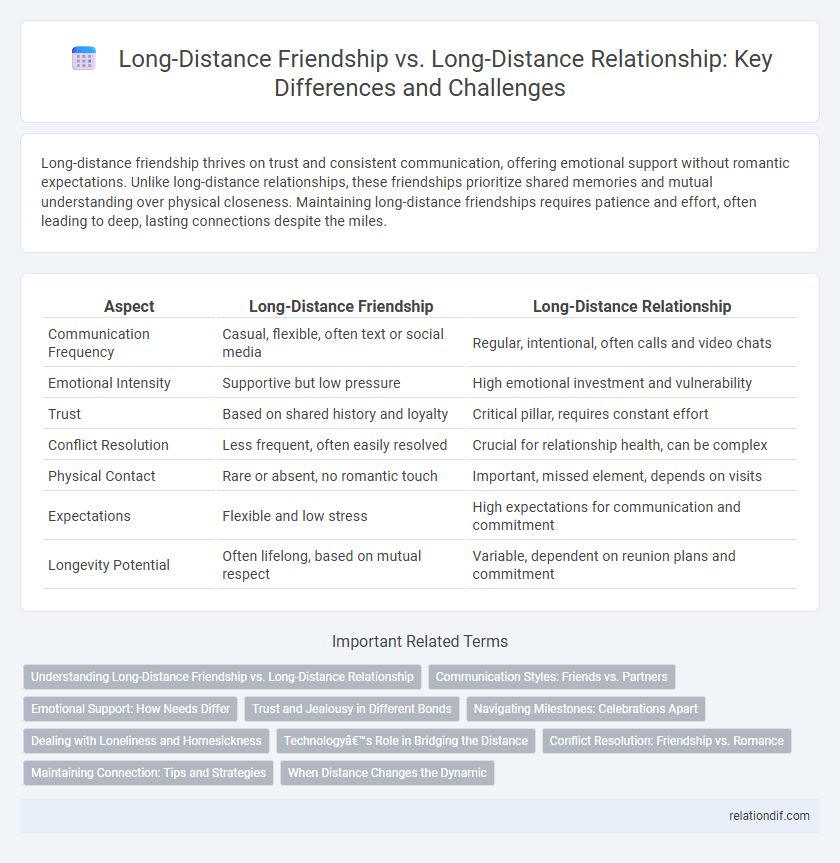Long-distance friendship thrives on trust and consistent communication, offering emotional support without romantic expectations. Unlike long-distance relationships, these friendships prioritize shared memories and mutual understanding over physical closeness. Maintaining long-distance friendships requires patience and effort, often leading to deep, lasting connections despite the miles.
Table of Comparison
| Aspect | Long-Distance Friendship | Long-Distance Relationship |
|---|---|---|
| Communication Frequency | Casual, flexible, often text or social media | Regular, intentional, often calls and video chats |
| Emotional Intensity | Supportive but low pressure | High emotional investment and vulnerability |
| Trust | Based on shared history and loyalty | Critical pillar, requires constant effort |
| Conflict Resolution | Less frequent, often easily resolved | Crucial for relationship health, can be complex |
| Physical Contact | Rare or absent, no romantic touch | Important, missed element, depends on visits |
| Expectations | Flexible and low stress | High expectations for communication and commitment |
| Longevity Potential | Often lifelong, based on mutual respect | Variable, dependent on reunion plans and commitment |
Understanding Long-Distance Friendship vs. Long-Distance Relationship
Long-distance friendships often rely on shared interests, trust, and consistent communication without romantic expectations, fostering deep emotional bonds despite physical separation. Long-distance relationships demand heightened emotional intimacy, commitment, and mutual effort to nurture romantic connection and navigate challenges like time zone differences and physical absence. Understanding these dynamics helps individuals maintain meaningful connections by tailoring communication and emotional support strategies to the unique needs of each type of long-distance bond.
Communication Styles: Friends vs. Partners
Long-distance friendships emphasize casual, frequent communication with flexible timing, allowing friends to share experiences and support without pressure. In contrast, long-distance relationships often require more structured and intimate communication, focusing on emotional depth and regular check-ins to maintain closeness. Partners prioritize clarity and conflict resolution, while friends value spontaneity and lighthearted exchanges.
Emotional Support: How Needs Differ
Long-distance friendships often provide consistent emotional support through shared interests and understanding without the complexities of romantic expectations, allowing for platonic reassurance and companionship. In contrast, long-distance relationships demand deeper emotional intimacy and frequent communication to sustain romantic bonds and mutual vulnerability. The emotional needs in friendships emphasize reliability and trust, while romantic relationships prioritize ongoing emotional connection and affirmation.
Trust and Jealousy in Different Bonds
Trust in long-distance friendships often remains more resilient due to established platonic boundaries and shared understanding, minimizing jealousy compared to romantic relationships where emotional intimacy heightens insecurity. Long-distance romantic partners frequently grapple with jealousy triggered by uncertainty and greater emotional vulnerability, impacting the stability of the relationship. The nature of bonds dictates how trust is maintained and jealousy is managed, with friendships relying on consistent communication and respect, while romantic relationships require deeper emotional reassurance and transparency.
Navigating Milestones: Celebrations Apart
Navigating milestones in long-distance friendships often involves creative virtual celebrations and meaningful gestures that maintain emotional connection despite physical separation. Unlike long-distance relationships, which may require deeper emotional intimacy and frequent communication to sustain romantic bonds, friendships rely on shared experiences and consistent support to honor important dates and achievements. Virtual parties, personalized messages, and scheduled video calls help preserve the sense of togetherness during birthdays, graduations, and other milestones.
Dealing with Loneliness and Homesickness
Long-distance friendships often provide a stable emotional anchor that helps alleviate feelings of loneliness and homesickness through consistent communication and shared memories. Unlike romantic relationships, friendships typically face less pressure to maintain frequent romantic interactions, allowing for more flexible support during emotionally challenging times. Both relationships benefit significantly from virtual meetups and timely check-ins, which foster a sense of closeness despite physical distance.
Technology’s Role in Bridging the Distance
Technology plays a crucial role in bridging the distance in both long-distance friendships and relationships by enabling instant communication through video calls, messaging apps, and social media platforms. Long-distance friendships often rely on shared digital experiences and group chats to maintain emotional closeness despite physical separation. In contrast, long-distance relationships may incorporate more frequent and intimate virtual interactions to nurture romantic bonds and sustain connection across miles.
Conflict Resolution: Friendship vs. Romance
Long-distance friendships often benefit from open communication and mutual understanding, allowing conflicts to be navigated with empathy and patience without the pressure of romantic expectations. In contrast, long-distance romantic relationships may face more intense emotional challenges due to heightened insecurities and the need for constant reassurance, making conflict resolution more complex. Effective resolution in both contexts relies on trust, clear boundaries, and consistent effort to maintain emotional connection despite physical distance.
Maintaining Connection: Tips and Strategies
Maintaining connection in long-distance friendships requires consistent communication through video calls, messaging apps, and shared virtual activities to bridge the physical gap. Establishing regular check-ins and celebrating milestones together fosters emotional intimacy and trust despite the distance. Utilizing technology tools like shared playlists, online games, or collaborative projects enhances engagement and keeps the bond vibrant over time.
When Distance Changes the Dynamic
Long-distance friendship relies on trust and shared memories to maintain emotional closeness despite physical separation, while long-distance relationships demand continuous communication and romantic commitment to sustain intimacy. Distance often tests boundaries differently: friendships tend to adapt with flexible interaction patterns, whereas romantic relationships require deliberate efforts to navigate expectations and emotional needs. Both dynamics face challenges like time zone differences and lack of physical presence, but successful navigation strengthens bonds and deepens mutual understanding.
long-distance friendship vs long-distance relationship Infographic

 relationdif.com
relationdif.com